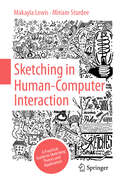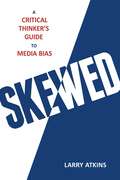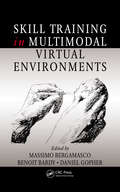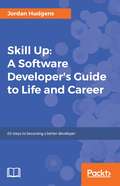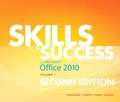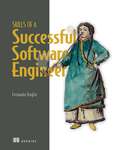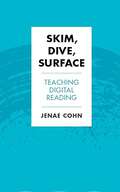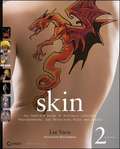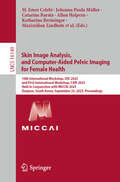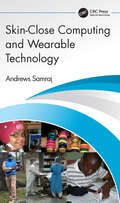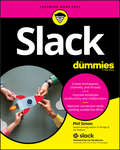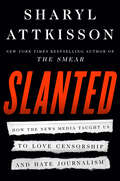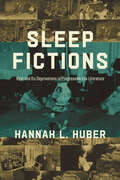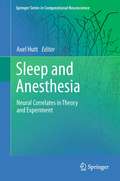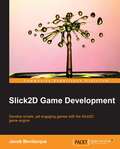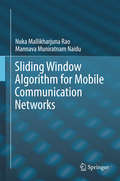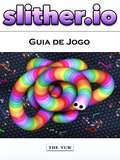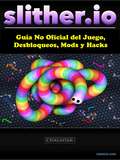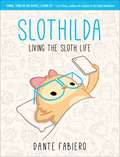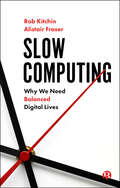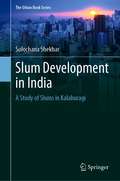- Table View
- List View
Sketching in Human Computer Interaction: A Practical Guide to Sketching Theory and Application
by Makayla Lewis Miriam SturdeeSketching is a universal activity that first appears when we play as children, but later, it is often overlooked as a useful skill in adult work – yet it can bring multiple benefits to research and practice in multiple domains. Specifically, Human Computer Interaction embraces interdisciplinary practices, and amongst those, sketching has proven to be a valuable addition to the skill set of researchers, practitioners, and educators in both academia and industry. Many individuals lack the confidence to take up pen and paper after years of non-practice, but it is possible to re-learn these lost skills, improve on them, and apply them in practical ways to all areas of work and research. This book takes the reader on an active journey in sketching: from scribbles and playful interpretations to hands-on practical applications in storyboarding, and further, in examining qualitative analysis using sketching practice in HCI. Readers will learn a wide range of techniques andapplied methods for utilizing sketching within the context of HCI, guided by the experienced authors, and join the larger community of those who employ (and enjoy) sketching in Human Computer Interaction.
Skewed: A Critical Thinker's Guide to Media Bias
by Larry AtkinsIn a media landscape dominated by advocacy news networks pushing competing points of view, how can the average person uncover the truth about any particular issue? This book will show you how to separate the facts from the agenda-driven spin and selective presentation often used by such news sources as Fox and MSNBC. The author describes the goals of advocacy journalism-i.e., journalism that transparently advocates a biased worldview-and shows that it has been a part of our history since the 1700s. He assesses the role of talk radio, cable news networks, and the more recent phenomena of special-interest blogs, websites, and citizen journalists in creating the current media climate. While conceding that advocacy journalism is undoubtedly popular and has some positive aspects, the author also points out its many negative features. Perhaps the most important of these is its polarizing effect on society. Skewed will give readers the tools to critique the media, to see both sides of any issue, and to become better informed citizens and voters.
Skill Training in Multimodal Virtual Environments (Human Factors and Ergonomics)
by Daniel Gopher Massimo Bergamasco BenoÎt BardyThe advent of augmented reality technologies used to assist human operators in complex manipulative operations-has brought an urgency to research into the modeling and training of human skills in Virtual Environments. However, modeling a specific act still represents a challenge in cognitive science. The same applies for the control of humanoid rob
Skill Up: A Software Developer's Guide to Life and Career
by Jordan HudgensThis unique book provides you with a wealth of tips, tricks, best practices, and answers to the day-to-day questions that programmers face in their careers. It is split into three parts: Coder Skills, Freelancer Skills, and Career Skills, providing the knowledge you need to get ahead in programming. About This Book • Over 50 essays with practical advice on improving your programming career • Practical focus gives solutions to common problems, and methods to become a better coder • Includes advice for existing programmers and those wanting to begin a career in programming Who This Book Is For This book is useful for programmers of any ability or discipline. It has advice for those thinking about beginning a career in programming, those already working as a fully employed programmer, and for those working as freelance developers. What You Will Learn • Improve your soft skills to become a better and happier coder • Learn to be a better developer • Grow your freelance development business • Improve your development career • Learn the best approaches to breaking down complex topics • Have the confidence to charge what you're worth as a freelancer • Succeed in developer job interviews In Detail This is an all-purpose toolkit for your programming career. It has been built by Jordan Hudgens over a lifetime of coding and teaching coding. It helps you identify the key questions and stumbling blocks that programmers encounter, and gives you the answers to them! It is a comprehensive guide containing more than 50 insights that you can use to improve your work, and to give advice in your career. The book is split up into three topic areas: Coder Skills, Freelancer Skills, and Career Skills, each containing a wealth of practical advice. Coder Skills contains advice for people starting out, or those who are already working in a programming role but want to improve their skills. It includes such subjects as: how to study and understand complex topics, and getting past skill plateaus when learning new languages. Freelancer Skills contains advice for developers working as freelancers or with freelancers. It includes such subjects as: knowing when to fire a client, and tips for taking over legacy applications. Career Skills contains advice for building a successful career as a developer. It includes such subjects as: how to improve your programming techniques, and interview guides and developer salary negotiation strategies. Style and approach This unique book provides over 50 insightful essays full of practical advice for improving your programming career. The book is split into three broad sections covering different aspects of a developer's career. Each essay is self-contained and can be read individually, or in chunks.
Skills For Success With Office 2010, Volume 1
by Shelley Gaskin Robert L. Ferrett Kris Townsend Catherine Hain Alicia VargasSkills for Success is written with today's students in mind. The book provides step-by-step guidance in an easy-to-use format. Each skill is presented on a two-page spread with clearly numbered steps and clear instruction. Key skills required to get started with Microsoft Office are covered, giving readers a complete introduction to the core tools.
Skills for Success With Office 2013
by Shelley Gaskin Kris Townsend Catherine Hain Stephanie Murre WolfFor use in the Office Applications course or readers that need to get started with Microsoft Office 2013. Skills for Success is the Microsoft Office 2013 textbook that recognizes how readers learn today! The Office Skills text that was designed with today's students--and the way today's readers use an Office textbook--in mind. With Skills for Success , Microsoft Office 2013 is at your fingertips! With Office 2013, Microsoft is taking the office to the cloud. You can now open and save your files from any computer without a USB flash drive. The Skills for Success series shows students how to get the most out of Office 2013 no matter what device they are using-a traditional desktop or tablet. Whether you are tapping and sliding with your finger or clicking and dragging with the mouse, Skills for Success shows you the way. Teaching and Learning Experience This program will provide a better teaching and learning experience-for you and your students. Here's how: Personalized Learning: MyITLab delivers proven results in helping students succeed, provides engaging experiences that personalize learning, and comes from a trusted partner with educational expertise and a deep commitment to helping students and instructors achieve their goals. Designed for a New Generation of Learners: The Skills for Success series is specifically designed to enhance usability and fit the work style of today's students. Support for Students and Instructors: Supplements enhance the learning process for students, while instructor resources are designed to make your life easier.
Skills of a Successful Software Engineer
by Fernando DoglioSkills to grow from a solo coder into a productive member of a software development team, with seasoned advice on everything from refactoring to acing an interview.In Skills of a Successful Software Engineer you will learn: The skills you need to succeed on a software development team Best practices for writing maintainable code Testing and commenting code for others to read and use Refactoring code you didn&’t write What to expect from a technical interview process How to be a tech leader Getting around gatekeeping in the tech community Skills of a Successful Software Engineer is a best practices guide for succeeding on a software development team. The book reveals how to optimize both your code and your career, from achieving a good work-life balance to writing the kind of bug-free code delivered by pros. You&’ll master essential skills that you might not have learned as a solo coder, including meaningful code commenting, unit testing, and using refactoring to speed up feature delivery. Timeless advice on acing interviews and setting yourself up for leadership will help you throughout your career. Crack open this one-of-a-kind guide, and you&’ll soon be working in the professional manner that software managers expect. About the technology Success as a software engineer requires technical knowledge, flexibility, and a lot of persistence. Knowing how to work effectively with other developers can be the difference between a fulfilling career and getting stuck in a life-sucking rut. This brilliant book guides you through the essential skills you need to survive and thrive on a software engineering team. About the book Skills of a Successful Software Engineer presents techniques for working on software projects collaboratively. In it, you&’ll build technical skills, such as writing simple code, effective testing, and refactoring, that are essential to creating software on a team. You&’ll also explore soft skills like how to keep your knowledge up to date, interacting with your team leader, and even how to get a job you&’ll love. What's inside Best practices for writing and documenting maintainable code Testing and refactoring code you didn&’t write What to expect in a technical interview How to thrive on a development team About the reader For working and aspiring software engineers. About the author Fernando Doglio has twenty years of experience in the software industry, where he has worked on everything from web development to big data. Table of Contents 1 Becoming a successful software engineer 2 Writing code everyone can read 3 Unit testing: delivering code that works 4 Refactoring existing code (or Refactoring doesn&’t mean rewriting code) 5 Tackling the personal side of coding 6 Interviewing for your place on the team 7 Working as part of a team 8 Understanding team leadership
Skim, Dive, Surface: Teaching Digital Reading
by Jenae CohnStudents are reading on screens more than ever—how can we teach them to be better digital readers? <P> Smartphones, laptops, tablets: college students are reading on-screen all the time, and digital devices shape students’ understanding of and experiences with reading. In higher education, however, teachers rarely consider how digital reading experiences may have an impact on learning abilities, unless they’re lamenting students’ attention spans or the distractions available to students when they’re learning online. <P> Skim, Dive, Surface offers a corrective to these conversations—an invitation to focus not on losses to student learning but on the spectrum of affordances available within digital learning environments. It is designed to help college instructors across the curriculum teach digital reading in their classes, whether they teach face-to-face, fully online, or somewhere in between. Placing research from cognitive psychology, neuroscience, learning science, and composition in dialogue with insight from the scholarship of teaching and learning, Jenae Cohn shows how teachers can better frame, scaffold, and implement effective digital reading assignments. She positions digital reading as part of a cluster of literacies that students should develop in order to communicate effectively in a digital environment.
Skin
by Rick Sammon Lee VarisRevised and thoroughly updated, this practical guide to photographing people is better than ever!What is the color of skin? You may think you know, until you enter the world of digital photography and try to reproduce what you see. Differences in software, lighting, computer calibration--everything has an impact on color. And that's all before you get into differences between people in terms of skin types, ethnicities, age, gender, and more! Hollywood-based photo-illustrator Lee Varis guides you step-by-step through the maze.This new edition covers the very newest trends and techniques in photographing, lighting, and editing skin--and offers plenty of tips, examples, and valuable advice from the author's own professional experience in the field.Shows you how to digitally capture all skin types: male, female, young, old, different skin tones and ethnicities, with makeup or without, wrinkled, tattooed, and moreCovers a wealth of topics in addition to photo editing, such as how to obtain model releases and compose shots, how to shoot groups, and how to create promotional headshotsIncorporates the latest on working with Photoshop and LightroomShowcases exceptional work from a variety of photographers and artistsIf you're photographing people, you'll want this valuable and unique guide on your shelf.
Skin Image Analysis, and Computer-Aided Pelvic Imaging for Female Health: 10th International Workshop, ISIC 2025, and First International Workshop, CAPI 2025, Held in Conjunction with MICCAI 2025, Daejeon, South Korea, September 23, 2025, Proceedings (Lecture Notes in Computer Science #16149)
by M. Emre Celebi Allan Halpern Jana Hutter Katharina Breininger Yuan Liu Kumar Abhishek Moi Hoon Yap Philipp Tschandl Johanna Paula Müller Catarina Barata Marc Combalia Joanna Jaworek-Korjakowska Richard Ruppel Maximilian Lindholz Smiti Tripathy Franziska Mathis-Ullrich Stefanie Burghaus Matthias MayThis book constitutes the refereed joint proceedings of the First International Workshop on Computer-Aided Pelvic Imaging for Female Health, CAPI 2025, and the 10th International Workshop on Skin Image Analysis, ISIC 2025, held in conjunction with the 28th International Conference on Medical Imaging and Computer-Assisted Intervention, MICCAI 2025, in , Daejeon, South Korea, in September 2025. The 7 full papers and 1 short paper presented at CAPI 2025, and the 6 full papers presented at ISIC 2018 were carefully reviewed and selected. CAPI 2025 focuses on women&’s reproductive health by linking the growing community with researchers working in Computer Assisted Intervention. ISIC 2025 focuses on advancements and knowledge dissemination in the field of skin image analysis, raising awareness and interest for these socially valuable tasks.
Skin-Close Computing and Wearable Technology
by Andrews SamrajThis book explains the concept of wearable computing, need for wearable technology, its advantages, application areas, state of art developments in this area, required material and technology, possible future applications including cyborg developments and the need for this sphere of influence in the future. The scope encompasses three major components, wearable computing (next generation of conventional computing, ergonomics), wearable technology (medical support, rehabilitation engineering, assistive technology support devices, army/combat usage) and allied technologies (miniature components, reliability, high performance integration, cyber physical systems, robotics). Aids reader to recognize the need and functional operations of a wearable computing device Includes diversified examples and case studies from different domains Presents a hybrid concept relating medical care and augmented reality Illustrates product level description examples and research ideas for future development Introduces various wearable technologies and other related technologies for enabling wearable computing This book is aimed at senior undergraduate, graduate students and researchers in computer and biomedical engineering, bioinstrumentation, biosensors, and assistive technology.
Skype Hacks
by Andrew SheppardIf you've heard about Skype--and who hasn't with all the recent media attention devoted to internet telephone services--chances are you've been mighty tempted to try it out. Skype Hacks tells you what all the Skype hype is about, explains the basics, and shows you more than 100 clever tips and tricks for tweaking and tuning Skype to make it do just what you want and more. Millions of people (48 million and counting, in fact) have opted for Skype, which uses peer-to-peer (P2P) technology to turn any PC, Mac, or Pocket PC into a telephone. Skype offers free calls between computers and extremely cheap calls to "old-fashioned" phone numbers (landlines and mobile phones). The sound quality is excellent, and end-to-end encryption means the connection is private and secure. But if you really know what you're doing, Skype can accomplish a whole lot more than that. Software developer and author Andrew Sheppard recently converted his entire house to Skype and uses it for all his personal and business calls, even when he's traveling. In Skype Hacks, he shows you how to do things with the technology that even the engineers at Skype probably never intended. Skype Hacks shows you how to: Get started with Skype Figure out how much money you're saving and maximize your savings Cut the ties to your old phone company Optimize your Skype configuration Integrate Skype with desktop tools like Microsoft Office and your web browser Set up a Skype-based call center The book offers ideas for creating and organizing a contacts list, using Skype to transfer files, taking advantage of chat and voicemail capabilities, turning a PDA into a mobile phone, and automating Skype for even greater efficiency. So whether you'd simply like to give Skype a trial run, you want new Skype ring tones and fun on-hold music, or you're considering wiring your home with Skype to get rid of "regular" phone service altogether, Skype Hacks is your ideal guide.
Skyrocket Your Business with Social Media Branding: Personalize, Increase, and Grow Demand for your Brand
by Isis BradfordSkyrocket Your Business with Social Media Branding"As a next-generation leader and trusted voice in the digital arena, Isis Bradford provides the blueprint to take your brand from the ground floor all the way to the top.” —Pauleanna Reid, founder of WritersBlok and nationally published journalistSkyrocket Your Business with Social Media Branding guides you on how to start and build your brand and business. Through social media branding and selling digital products, you can scale your business to be extremely lucrative—let’s get started!Grow your business and your brand. Social media strategist and content expert Isis Bradford created this guide book to help small business owners acclimate to social media branding and promoting digital products and goods. Learn how to utilize an instagram following to your advantage without a business development manager using Bradford’s The P.A.I.D. Equation method. P.A.I.D stands for how to (P)personalize the experience of your audience, bring (A)awareness to your business daily, create an (I)intimate relationship with those who are ready to shop from you, and increase (D)demand for purchases!Social media and business strategies made simple. Engage with your audience using updated strategies on social media branding. Learn how to personalize intended experiences for your audience, build brand awareness daily on social media, and inspire your audience to purchase any of your digital products and courses without famous influencers. Inside, you’ll find:Marketing and social media branding guidelines to grow your businessBusiness strategies to inspire purchases of your digital products and coursesAn online business book taking digital serial entrepreneurs to the next levelIf you liked Hook Point, The Nuclear Effect, or The Fearless Woman's Guide to Starting a Business, you’ll love Skyrocket Your Business with Social Media Branding.
Slack For Dummies
by Phil SimonSay goodbye to the old, inefficient way of working Have you ever wondered what it would feel like to be less overwhelmed, more efficient, and more engaged at work? Imagine being able to quickly and easily locate key documents and conversations. Every day, more than twelve million employees need not wonder. By using a remarkably useful, flexible, popular, affordable, and intuitive tool called Slack, they have fundamentally changed how they work. Slack For Dummies provides an approachable road map to understanding how to use Slack to maximum effect. This easy-to-use reference guide explores the Slack user interface and its key features. It walks you through the process of setting up workspaces, channels, and threads. It also offers insight on how to get your colleagues on board with this modern way of communicating and collaborating. Navigate Slack’s user interface and understand its key features Guide you through the process of creating workspaces, channels, and threads Provide additional context to group and individual messages Extend the power of Slack with third-party apps and integrations Improve employee morale and productivity Slack For Dummies is a full-color, step-by-step resource that will change the way that you communicate and collaborate with your colleagues—for the better and for good.
Slanted: How the News Media Taught Us to Love Censorship and Hate Journalism
by Sharyl AttkissonUSA TODAY BESTSELLER!New York Times bestselling author Sharyl Attkisson takes on the media’s misreporting on Black Lives Matter, coronavirus, Joe Biden, Silicon Valley censorship, and more.When the facts don’t fit their Narrative, the media abandons the facts, not the Narrative. Virtually every piece of information you get through the media has been massaged, shaped, curated, and manipulated before it reaches you. Some of it is censored entirely. The news can no longer be counted on to reflect all the facts. Instead of telling us what happened yesterday, they tell us what’s new in the prepackaged soap opera they’ve been calling the news.For the past four years, five-time Emmy Award–winning investigative journalist and New York Times bestselling author Sharyl Attkisson has been collecting and dissecting alarming incidents tracing the shocking devolution of what used to be the most respected news organizations on the planet. For the first time, top news executives and reporters representing every major national television news outlet—from ABC, CBS, NBC, and CNN to FOX and MSNBC—speak frankly, confiding in Attkisson about the death of the news as they once knew it. Their concern transcends partisan divides.Most frightening of all, a broad campaign in the media has convinced many Americans not only to accept but to demand censorship over journalism. It is a stroke of genius on the part of those seeking to influence public opinion: undermine public confidence in the news, then insist upon “curating” information and divining the “truth.” The thinking is done for you. They’ll decide which pesky facts shouldn’t cross your desk by declaring them false, irrelevant, debunked, unsafe, or out-of-bounds.We have reached a state of utter absurdity, where journalism schools teach students that their own, personal truth or chosen narratives matter more than reality. In Slanted, Attkisson digs into the language of propagandists, the persistence of false media narratives, the driving forces behind today's dangerous blend of facts and opinion, the abandonment of journalism ethics, and the new, Orwellian definition of what it means to report the news.
Sleep Fictions: Rest and Its Deprivations in Progressive-Era Literature (Topics in the Digital Humanities)
by Hannah L. HuberThe literary response to the dawning cult of wakefulness A turn-of-the-century influx of new technologies and the enormous impact of the electric light transformed not only individual sleeping habits but the ways American culture conceived and valued sleep. Hannah L. Huber analyzes the works of Henry James, Edith Wharton, Charles Chesnutt, and Charlotte Perkins Gilman to examine the literary response to the period’s obsession with wakefulness. As these writers blurred the separation of public and private space, their characters faced exhaustion in a modern world that permeated every moment of their lives with artificial light, traffic noise, and the social pressure to remain active at all hours. The implacable cultural clock and constant stress over physical limitations had an even greater impact on marginalized figures. Huber pays particular attention to how these writers rebutted Americans’ confidence in the body’s ability to conquer sleep with vivid portraits of the devastating consequences of sleep disruption and deprivation. The author also provides a website and text visualization tool that offers readers an interdisciplinary, deconstructed analysis of the book’s primary texts. The website can be found at: https://sleepfictions.org/sleep/scalar/index
Sleep and Anesthesia
by Axel HuttSleep and anesthesia resemble in many ways at a first glance. The most prominent common feature of course is the loss of consciousness, i.e. the loss of awareness of external stimuli. However a closer look at the loss of consciousness reveals already a difference between sleep and anesthesia: anesthesia is induced by an anesthetic drug whereas we may fall asleep without external cause. Other questions may arise about the difference of the two effects: do we dream during surgery under anesthesia, do we feel pain during sleep? Essentially, we may ask: what is common and what are the differences between sleep and anesthesia? To answer these questions, we may take a look at the neural origin of both effects and the involved physiological pathways. In which way do they resemble? Moreover, we ask what are the detailed features of normal sleep and general anesthesia as applied during surgery and which features exist in both phenomena? If yes in which way? To receive answers to these questions, it is necessary to consider several experimental techniques that reveal underlying neural mechanisms of sleep and anesthesia. Moreover, theoretical models of neural activity may model both phenomena and comes up with predictions or even theories on the underlying mechanisms. Such models may attack several different description levels, from the microscopic level of single neurons to the macroscopic level of neural populations. Such models may give deeper insight into the phenomena if their assumptions are based on experimental findings and their predictions can be compared to experimental results. This comparison step is essential for valuable theoretical models. The book is motivated by two successful workshops on anesthesia and sleep organized during the Computational Neuroscience Conferences in Toronto in 2007 and in Berlin 2009. It aims to cover all the previous aspects with a focus on the link to experimental findings. It elucidates important issues in theoretical models that at the same time reflect some current major research interests. Moreover it considers some diverse issues which are very important to get an overview of the fields. For instance, the book discusses not only neural activity in the brain but also the effects of general anesthesia on the cardio-vascular system and the spinal cord in the context of analgesia. In addition, it considers different experimental techniques on various spatial scales, such as fMRI and EEG-experiments on the macroscopic scale and single neuron and LFP-measurements on the microscopic scale. In total all book chapters reveal aspects of the neural correlates of sleep and anesthesia motivated by experimental data. This focus on the neural mechanism in the light of experimental data is the common feature of the topics and the chapters. In addition, the book aims to clarify the shared physiological mechanisms of both phenomena, but also reveal their physiological differences.
Slick2D Game Development
by Jacob BevilacquaA simple guide, packed with tutorials that ease you into learning about the Slick game workflow and Slick game library.If you are a game programmer who would like to expand on your skills and become a game developer, this book is ideal for you. No previous knowledge of Slick 2D or any other Java game library is required. This book assumes that you have basic Java syntax and object oriented programming knowledge.
Sliding Window Algorithm for Mobile Communication Networks
by Nuka Mallikharjuna Rao Mannava Muniratnam NaiduThis book offers a broad overview of mobile communications and its databases, focusing on the processes and methods used in mobile communication networks. Drawing upon the insights of leading researchers, the book’s main focus is on the sliding window algorithm. In addition, the book discusses queuing theory concepts for measuring the realistic throughput and performance of mobile switching centers in global system for mobile communications (GSM) networks by applying the sliding window algorithm. Practical case studies, a full set of easy-to-access supplements, and extensive web resources make reading, learning about and teaching mobile communications easier than ever.
Slither.io Guia de Jogo
by Hiddenstuff Entertainment Gerlon de Jesus Magalhães Santos* Guia não-oficial * Dicas avançadas & Guia de Estratégia. Este é o guia mais completo e mais detalhado que você vai encontrar online. Disponível para download imediato em seu celular, dispositivo de e-book, ou em forma de livro. Com o sucesso das minhas centenas de outros guias e estratégias que escrevi, escrevi um outro guia profissional avançado para os jogadores novos e veteranos. De estratégias e dicas específicas sobre como progredir no jogo, bater os seus adversários, adquirir mais e mais moedas, e muito mais! - Dicas profissionais e Estratégias. - Cheats e Hacks. - Segredos, Dicas, Cheats, Destraves e Truques usados pelos jogadores profissionais! - Como Conseguir Toneladas de Dinheiro / Moedas. - E muito mais! Todas as versões deste guia tem capturas de telas para ajudar você a entender melhor o jogo. Não há nenhum outro guia que é tão abrangente e avançada como este.
Slither.io Guía No Oficial del Juego, Desbloqueos, Mods y Hacks
by Hiddenstuff Entertainment Smart Copy TranslationGuía No Oficial para el juego Slither.io. Descargables, estrategias y consejos. Domina el juego desde el principio.
Slothilda: Living the Sloth Life
by Dante FabieroSlothilda is your spirit animal! Enjoy this completely relatable comic series about an adorable little sloth who's driven by her desire for self-improvement. Unfortunately, achieving her goals isn't always so easy. After all, she is a sloth, and being innately lazy often poses some interesting challenges to her personal growth. She constantly struggles to overcome procrastination, her love for junk food, and her addiction to modern day technology. Despite her lazy natural instincts, Slothilda remains ambitious and optimistic. She explores an inner conflict we can all relate to—the desire to succeed and grow, while paradoxically dealing with the ever present temptation to sloth.
Slow Computing: Why We Need Balanced Digital Lives
by Rob Kitchin Alistair FraserDigital technologies should be making life easier. And to a large degree they are, transforming everyday tasks of work, consumption, communication, travel and play. But they are also accelerating and fragmenting our lives affecting our well-being and exposing us to extensive data extraction and profiling that helps determine our life chances. Initially, the COVID-19 pandemic lockdown seemed to create new opportunities for people to practice ‘slow computing’, but it quickly became clear that it was as difficult, if not more so, than during normal times. Is it then possible to experience the joy and benefits of computing, but to do so in a way that asserts individual and collective autonomy over our time and data? Drawing on the ideas of the ‘slow movement’, Slow Computing sets out numerous practical and political means to take back control and counter the more pernicious effects of living digital lives.
Slum Development in India: A Study of Slums in Kalaburagi (The Urban Book Series)
by Sulochana ShekharThis book is an earnest effort in understanding the slums and their needs by taking a case study of Kalaburagi, India. This study aims to contribute sustainable methodologies to advance the living conditions of slum dwellers and for better execution of slum policies. The core objectives are: 1) mapping the existing slums of Kalaburagi (formerly Gulbarga) city using slum ontology from very high-resolution data and validating the slum map through ground survey and using reliable data; 2) developing a model to understand the factors which are responsible for the present growth as well as to predict the future growth of slums; 3) estimating the housing demand of urban poor and suggesting a suitable site for the rehabilitation program; and 4) suggestions for the better intervention of government policies with special reference to in-situ program.Urban is the future, and slums are its reality. Sustainable development goals are directly and indirectly concerned about the increasing urbanization and the slums. Housing the urban poor and affordable housing to all are the national missions. Practically making these plans successful depends on a deep understanding of urban issues and proper methodology and technology to handle it. The participatory slum mapping, cellular automata slum model, housing demand analysis, and the spatial decision support system demonstrated in the book help in monitoring and managing the slums and thus lead towards a slum-free India.
